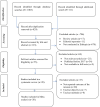Occupational Related Upper and Low Back Pain Among the Working Population of Ethiopia: Systematic Review and Meta-Analysis
- PMID: 35002252
- PMCID: PMC8728766
- DOI: 10.1177/11786302211067839
Occupational Related Upper and Low Back Pain Among the Working Population of Ethiopia: Systematic Review and Meta-Analysis
Abstract
Background: Back pain, such as upper and low back pain are among the most common musculoskeletal conditions that can cause major public health and socioeconomic problems. Back pain is one of the leading causes of disability that reduces worker performance and well-being and increases absence from work, which can cause an enormous economic burden. In developing countries, particularly in Ethiopia, there is no adequate evidence on the overall prevalence of occupational-related upper and low back pain, and they remain less prioritized and empirically unrepresented. Therefore, this study aimed to determine the prevalence of occupational-related upper and low back pain among the working population of Ethiopia.
Methods: This systematic review and meta-analysis considered studies conducted in Ethiopia, written in English, and published from 2017 to 2020. Articles were searched from 9 electronic databases (Web of Science, SCOPUS, PubMed, Google Scholar, CINAHL, Cochrane Library, African Index Medicus, African Journals Online database, and Science Direct) using a combination of Boolean logic operators, Medical Subject Headings, and main keywords. The quality assessment of the articles was performed using the Joanna Briggs Institute Critical Appraisal tools to determine the relevance of the articles to the study. A random effects model was used to estimate the pooled prevalence, the 95% confidence interval, and the degree of heterogeneity among the included studies. Sensitivity analyses were performed to identify the influence of outliers and to identify sources of heterogeneity.
Results: Of the 1114 studies identified from the included databases, 20 studies were included in the systematic review and meta-analysis. The pooled prevalence of occupational-related upper and low back pain in the previous year was (27.1% [95% CI: 18.4, 37.9]) and (54.2% [95% CI: 48.2, 60.0]), respectively. Based on a subgroup analysis by publication year, study population, and regions where the studies were conducted, the prevalence of upper back pain was (43.8% [95% CI: 39.3, 47.7]), (34.7% [95% CI: 33.1, 36.2]), and (36.2% [95% CI: 33.6, 39.0]), respectively, while the prevalence of low back pain was (61.8% [95% CI: 58.9, 64.6], (52.8% [95% CI: 51.3, 54.3]), and (55.2% [95% CI: 51.4, 59.0]), respectively.
Conclusions: This systematic review and meta-analysis found that 54.2% of the included study participants experienced low back pain in the previous year, while 27.1% experienced upper back pain. The highest prevalence was reported among pedestrian back-loading women.
Keywords: Back pain; Ethiopia; low back pain; musculoskeletal disorders; occupational health; upper back pain.
© The Author(s) 2021.
Conflict of interest statement
Declaration of conflicting interests: The author(s) declared no potential conflicts of interest with respect to the research, authorship, and/or publication of this article.
Figures






Similar articles
-
Occupational-Related Upper and Lower Extremity Musculoskeletal Pain Among Working Population of Ethiopia: Systematic Review and Meta-Analysis.Inquiry. 2022 Jan-Dec;59:469580221088620. doi: 10.1177/00469580221088620. Inquiry. 2022. PMID: 35574938 Free PMC article.
-
The prevalence of occupational-related low back pain among working populations in sub-saharan Africa: a systematic review and meta-analysis.J Occup Med Toxicol. 2024 Oct 18;19(1):39. doi: 10.1186/s12995-024-00438-1. J Occup Med Toxicol. 2024. PMID: 39425126 Free PMC article.
-
Prevalence of Self-Reported Work-Related Lower Back Pain and Its Associated Factors in Ethiopia: A Systematic Review and Meta-Analysis.J Environ Public Health. 2021 Sep 23;2021:6633271. doi: 10.1155/2021/6633271. eCollection 2021. J Environ Public Health. 2021. PMID: 34603457 Free PMC article.
-
Worldwide Prevalence of Occupational Exposure to Needle Stick Injury among Healthcare Workers: A Systematic Review and Meta-Analysis.Can J Infect Dis Med Microbiol. 2021 Jan 29;2021:9019534. doi: 10.1155/2021/9019534. eCollection 2021. Can J Infect Dis Med Microbiol. 2021. PMID: 33564345 Free PMC article. Review.
-
Precancerous cervical lesion in Ethiopia: systematic review and meta-analysis.Syst Rev. 2021 Nov 1;10(1):287. doi: 10.1186/s13643-021-01840-0. Syst Rev. 2021. PMID: 34724978 Free PMC article.
Cited by
-
Physical therapy registries worldwide: A systematic review.Health Sci Rep. 2024 Sep 16;7(9):e2312. doi: 10.1002/hsr2.2312. eCollection 2024 Sep. Health Sci Rep. 2024. PMID: 39286739 Free PMC article. Review.
-
A systematic review and meta-analysis of low back pain and its associated factors among school teachers in Africa.BMC Musculoskelet Disord. 2023 Jun 17;24(1):499. doi: 10.1186/s12891-023-06633-1. BMC Musculoskelet Disord. 2023. PMID: 37330490 Free PMC article.
References
-
- World Health Organization (WHO). Musculoskeletal conditions, key facts. 2021. Accessed March 1, 2021. https://www.who.int/news-room/fact-sheets/detail/musculoskeletal-conditions
-
- Hoy D, March L, Brooks P, et al.. The global burden of low back pain: estimates from the Global Burden of Disease 2010 study. Ann Rheum Dis. 2014;73(6):968-974. - PubMed
-
- Punnett L, Prüss-Utün A, Nelson DI, et al.. Estimating the global burden of low back pain attributable to combined occupational exposures. Am J Ind Med. 2005;48:459-469. - PubMed
Publication types
LinkOut - more resources
Full Text Sources

